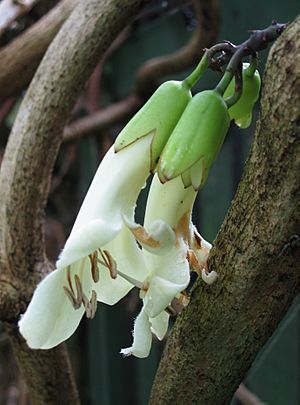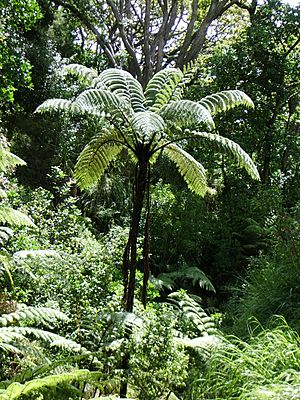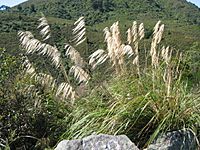Flora of New Zealand facts for kids

This article is about the amazing plants that grow naturally in New Zealand. Because New Zealand has been separated from other lands for a very long time, it has developed many unique plants. These are called indigenous or native plants. However, over time, people have brought many other plants to New Zealand. These are often called 'exotic' plants. Sadly, some of these new plants, along with farming, have caused damage to the native plants, especially after Europeans arrived.
Contents
What Makes New Zealand Plants Special?
New Zealand's native plants have some cool features:
- Most of them stay green all year round.
- There are only a few small plants that live for just one year.
- Not many trees can handle very cold weather.
- Birds help spread the seeds for most plants.
- They don't have many ways to protect themselves from animals that eat plants, like mammals.
- Few plants can create their own nitrogen, which is a nutrient they need.
- Not many species are good at surviving fires.
- Many plants have separate male and female plants.
- Their flowers are usually small and white.
- Many plants grow in a special way called 'divaricating', where branches criss-cross.
- Some plants have grown much larger than their relatives in other countries.
Types of New Zealand Plants
Trees and Shrubs
New Zealand is home to many unique trees and shrubs. Here are some of them:
|
|
|
Ferns
Even though most ferns grow in warm, tropical places, New Zealand has a surprising number of them for a cooler country! They come in many shapes, from the classic feather-like ferns to tall tree ferns, and even thin, leafy, or climbing ferns. The koru, which looks like an unfurling fern frond, and the silver fern are both important symbols of New Zealand.
New Zealand has ten types of tree ferns. There are also many smaller ferns that grow on the ground, climb, or perch on other plants in the forests. The largest of these is the King fern.
- Silver fern or Ponga, Cyathea dealbata
- New Zealand Tree Fern, Dicksonia squarrosa
- Black Tree Fern or Mamaku, Cyathea medullaris
- Tuokuro, Dicksonia lanata
- Kuripaka, Dicksonia fibrosa
- Mountain Tree Fern, Cyathea colensoi
- Gully Tree Fern, Cyathea cunninghamii
- Soft Tree Fern, Cyathea smithii
- King fern, Ptisana salicina
- Prince of Wales fern, Leptopteris superba
- Hound's tongue fern, Microsorum pustulatum
- Kidney fern or Raurenga, Trichomanes reniforme
- Hen and chickens fern, Asplenium bulbiferum
- Hanging spleenwort, Asplenium flaccidum
- Mangemange, Lygodium articulatum
Seaweeds
- Neptune's necklace
Liverworts
New Zealand has more types of liverworts than any other country! This is because of its cool, wet weather. About half of these liverworts are found only in New Zealand.
There are over 600 known types of liverworts in New Zealand. Some look like flat, liver-shaped leaves, but most have tiny leaves and can be mistaken for mosses or small ferns. Scientists are still finding new kinds of liverworts in New Zealand's forests.
Grasses
New Zealand has 187 types of native grasses. Most of these (157 species) are found only in New Zealand. The other 30 species are also native but can be found in other places too.
These grasses belong to different groups and families, including:
|
|
Mosses
There are over 500 known types of mosses in New Zealand. Many of these (108 species) are found only in New Zealand. Most New Zealand mosses came from an ancient supercontinent called Gondwana. This means they are related to mosses found in Tasmania, Australia, and parts of South America.
Some types of mosses found only in New Zealand are:
|
|
|
Sphagnum moss is also important for the economy.
Other Interesting Plants

New Zealand has many other unique plants, including:
- Bush lawyer
- Celmisia (Mountain Daisy)
- Megaherbs (very large herbs)
- Nine types of mistletoe, including Peraxilla colensoi and Peraxilla tetrapetala. One type, Trilepidea adamsii, was last seen in 1954 and is now extinct.
- Mount Cook Lily
- New Zealand flax
- New Zealand spinach (Kokihi)
- Nikau Palm
- Pingao
- Raupō or bulrush
- Supplejack
- Tecomanthe speciosa
- Wood rose



